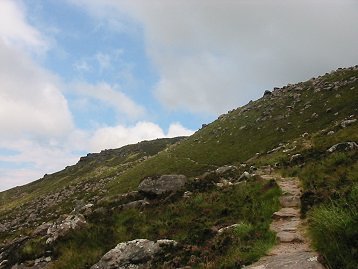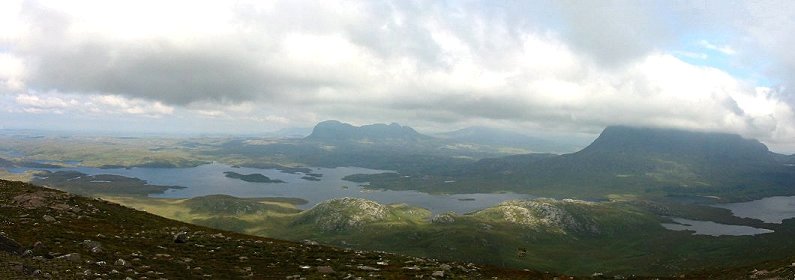
View from Stac Pollaidh overlooking the Inverpolly National Nature Reserve with Loch Sionascaig,
the impressive rock of Suilven in the background and Cul Mor to the right in the clouds
Go to Map of northern Scotland
Go to Siv - Home
Day 7
Our first day in Ullapool had been pretty rainy and people flocked to The Seaforth Inn early in the evening. It is a friendly and touristy restaurant in the main street right next to and overlooking the colorful fishing boat harbor from the upstairs restaurant. This first evening we had to wait for a half hour or so at the bar, sipping Scotch of course and enjoying the lively crowd of tourists in the crammed full upstairs room. We came back to that restaurant two more times, finding the ambiance immensely more 'gemütlich' and the food better than in another place we tried once. There was a lively bar downstairs where they also served dinner, but for some reason we chose the restaurant, which had a slightly different menu.
From the big windows you saw the wonderfully picturesque harbor and after most people had finished their dinner, the town band went parading down the street and around the corner, with bagpipes, drums and trombones - the band players wearing Scottish outfits of course. Very touristy and we loved it.
We had mostly cloudy days but no rain on our walks from Ullapool, and the sun usually came out towards the afternoon and evening and shed a magic light on the colorful fishing boats in the harbor.
On our way to the Rua lighthouse we left the path to explore some ancient vestiges of what are called 'roundhouses' from prehistoric times. It felt almost eery to be standing in the middle of these remnants from a long gone era.
 |
 |
 |
 |
| The
entrance to Loch Broom and Ullapool |
The Rua lighthouse |

Another couple we met tried to get over the rocky hill from the side towards the loch to get to the other side, but they discovered it wasn't really possible. So we walked across the moor and John decided to make the rather short ascent from the land side. I sat down below waiting for his silhouette to appear on the horizon. Here he is emerging finally.

the setting sun over the entrance to Loch Broom from Ullapool harbor.
Day
8 

We
are following a shallow stream on our way to the ruins of an ancient
fort, Dun
Canna, the oldest existing ruins of a fort in this part of
the world, built to guard
the Scots against the vikings who arrived in hoards from Norway to
invade Scotland. There were very
close links
between Norway and this part of
the Scottish Highlands, and there still are today,
even though a lot
more
peaceful. 

John at the top of the ancient fort constructed to guard the Scots against hirsute vikings
We climb over it, across a
mess of
rocks and take shelter
against the fierce wind to eat our sandwiches.

against the fierce wind to eat our sandwiches.

View towards
the wide west from
the remaining ruins of this ancient fort

the remaining ruins of this ancient fort

Looking out towards the loch and over the beach - from the
spot we picked for lunch
at the ancient fort of Dun Canna
at the ancient fort of Dun Canna
Day 9
The ascent of Stac Pollaidh
 |
 |
|
"No walker who visits Coigach
will be able to resist the ascent of Stac Pollaidh. ...As you drive
north from Ullapool it bursts into view behind the tree-ringed loch at
Drumrunie."
|
The craggy top of Stac Polly seen from some distance below. |
 |
 |
| We
are working our way up to the top among rocks and grass -
meeting and chatting with lots
of nice people, from Germans to English to
Italians. |
The western peak of Stac Polly, looming behind John |
 |
"From the Nature Reserve car park beside Loch Lurgainn a path climbs three giant steps of ever increasing steepness straight to the summit ridge." "The path is rather loose and bouldery at the top, but this should not deter you from making the ascent which will take about one hour and it is surprisingly strenuous." ("Exploring the far North West of Scotland" by Richard Gilbert) |

"As soon as you reach the summit
ridge you are confronted by an
astonishing panoramic view encompassing the indented western coastline,
Cul Mor, Suilven, Canisp, Quinag and distant Foinaven."
(Quote from "Exploring the far North West of
Scotland" by Richard
Gilbert)
As we were coming down from Stac Polly, realizing what a good climb up it had been and well understanding that we were feeling it in our legs and bodies, the mountain behind us was getting increasingly covered in a cloud of fog and rain. We still met some people on their way up and we were wondering how far they had gotten before the downpour caught up with them. We had taken our time, and the parking lot was pretty much emptied out, apart from some pro looking hikers who were probably going to spend the night in tents somewhere (the Weit Wander Weg kind of hikers). We were still feeling pretty good about having managed the ascent to see this marvel which we had already fallen in love with from our guide book at home in Lyon, "Exploring the far North West of Scotland" by Richard Gilbert.
Day 10
Leaving Ullapool, heading for Durness on the north coast
 |
Leaving Ullapool the next day, we passed through a prehistoric-looking countryside, going north in the direction of Durness. The moors and mountains around us were getting increasingly stark and beautiful, 'Urwelt' looking moutains rising out of the wide gently rolling moor. |
Quinag's Sail Gharbh, 808m in "uninhabited, barren and
rugged mountain country "- seen from the road
going north from Ullapool. "Unrelentingly steep slopes, weathered in
places into sheer cliffs, fall from the Y-shaped ridges which enclose
deep corries."
"The rock turret of Quinag's Spidean Coinich set against a blue sky" is on the left and behind. Sail Gorm is barely showing behind and on the right. This was one of the most awe-inspiring wilderness scenes we saw on this trip. Wider panorama at the top of Scotland - part 1 (Quotes from "Exploring the far North West of Scotland" by Richard Gilbert)

"The rock turret of Quinag's Spidean Coinich set against a blue sky" is on the left and behind. Sail Gorm is barely showing behind and on the right. This was one of the most awe-inspiring wilderness scenes we saw on this trip. Wider panorama at the top of Scotland - part 1 (Quotes from "Exploring the far North West of Scotland" by Richard Gilbert)
 |
Ardvreck Castle seen from the road to Durness |

A heathery heath on the west coast of Scotland.

A view out towards the sea from Scourie Bay on the west coast of Scotland.
| A wide glacial glen leading down to Durness. |
 |
We arrived in Durness that evening and the house where we had booked a room was set pretty much on the edge of the northern coast of Scotland. A little girl was watching us timidly - standing by a low wall towards the sea, as we were carrying our bags through a back verandah into our very nice room. I asked the girl "Do you ever go swimming in the sea?" - She said "Yes." I tried once again getting her out of her silence: "Isn't the water a bit cold?" She said "Yes."
Our room was tastefully decorated in deep red and green, what we got to see as the Scottish colors, the deep red of the heather against the green fern on the moors.
Day 11
We set out from Durness in the morning headed for Thurso (most likely = Thor's Island) where we were planning to spend the night, before taking the ferry to Stromness on the southern coast of the Mainland of the Orkney Islands. We were following the northern coast of Scotland all the way and the scenery was sheer magic. On the northern coast of Scotland and, even more so, on the Orkney Islands, Old Norse place names were in abundance. The viking invaders, who then in large numbers became settlers, mixed in with the Scots, the same way as they did on the east coast of Ireland - and of course in Normandy, the land of North men.
 |
 |
Smoo Cave, which we visited just outside of Durness. Oodles of tourists were streaming in and out, Italians,
French, Asiatics and maybe even some English tourists. A constructed pathway for visitors leads down from
the road to the entrance to the cave.
 |
 |
The northern coast of Scotland

A beach on the northern coast of Scotland.
Oh, the wide open beaches, the green and blue clear water and the gentle green hills of the Scottish coasts.
 |
 |
|
Reflections of the sun on
the water
Ben Loyal seen from the
Kyle of Tongue (kyle = inlet)
|
Mysterious northern coast of Scotland |
That evening in Thurso, we had dinner at the restaurant 'Le Bistro' in the main street of Thurso which our hosts had recommended. We were staying a little way outside of town so we took the car to get there. Since we were both in a good mood we were happily chatting away throughout the dinner about places we had seen that day and where we were going the next day. I noticed that a gentleman at the table on my left was very discreetly paying attention to us. He was dining alone and he seemed a very likeable man. As he was leaving, he aplogized for his temerity but introduced himself and asked us if we would like to join him for a chat at his house after we were through with dinner. John skipped his dessert and we joined him outside in the street.
This gentleman was one of our fondest memories from our two weeks in Scotland. He turned out to be a widower, as we had guessed of course. He was 82 years old he told us and he was the only still living WWII air force veteran in his town. He was in the Royal Air Force during the allied invasion of Normandy on June 6, 1944. He had made three tours dropping parachuters behind the front lines over Normandy. Most of his friends had not survived D-day. He showed us albums with photos and newspaper clippings. We exchanged addresses of course and we hope we'll see him again, maybe as a guest in our house, maybe in Thurso. We shall see.
Next - Part 4
Go to Site map